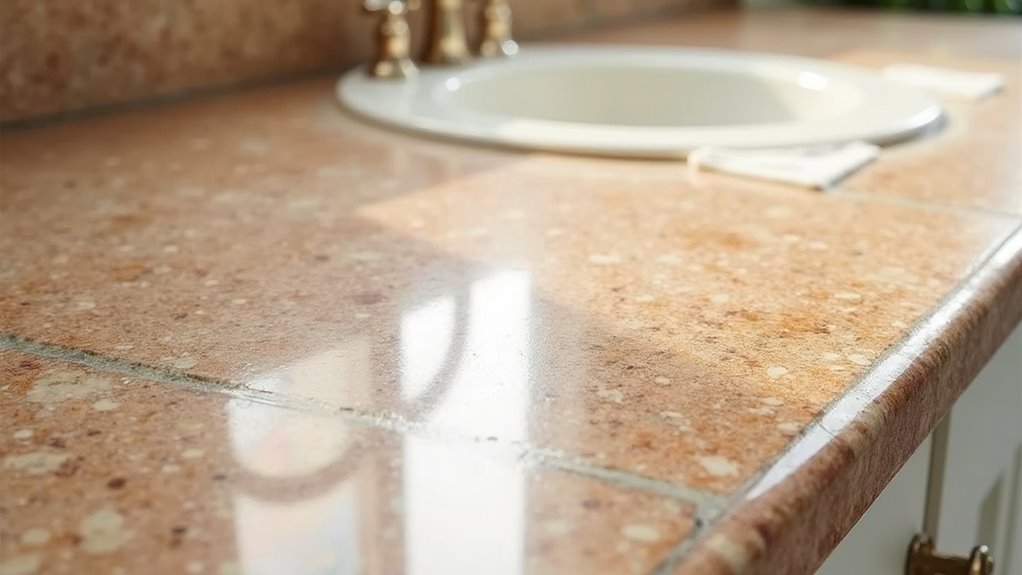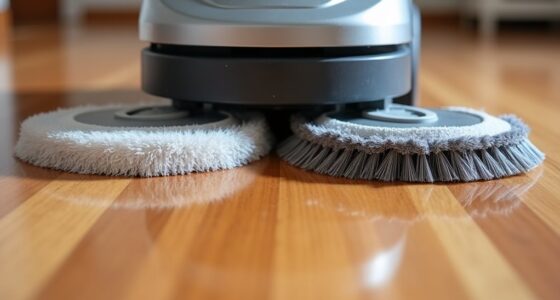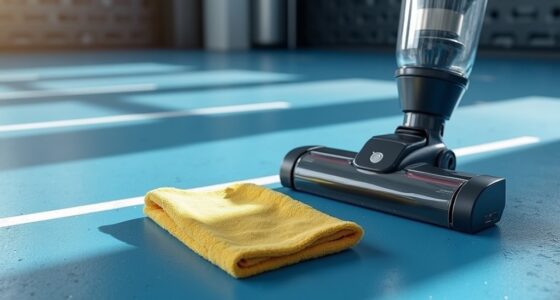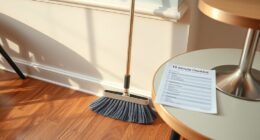To stop squeegee streaks on your natural stone in just three minutes, start by gently wiping the surface with a soft, damp microfiber cloth using a pH-neutral cleaner designed for stone. Rinse with clean water and dry thoroughly with a lint-free towel to prevent water spots. Applying a high-quality stone sealant can also help reduce streaks long-term. Want more tips to keep your stone pristine and streak-free? Keep going to learn the complete solution.
Key Takeaways
- Use a soft, damp microfiber cloth with a pH-neutral stone cleaner to wipe in gentle, circular motions.
- Rinse the surface thoroughly with clean water to remove residue that causes streaks.
- Dry immediately with a clean, lint-free towel to prevent water spots and streak formation.
- Apply a high-quality stone sealant periodically to reduce moisture absorption and streak visibility.
- Avoid acidic cleaners like vinegar or lemon juice, which can etch the stone and worsen streaks.
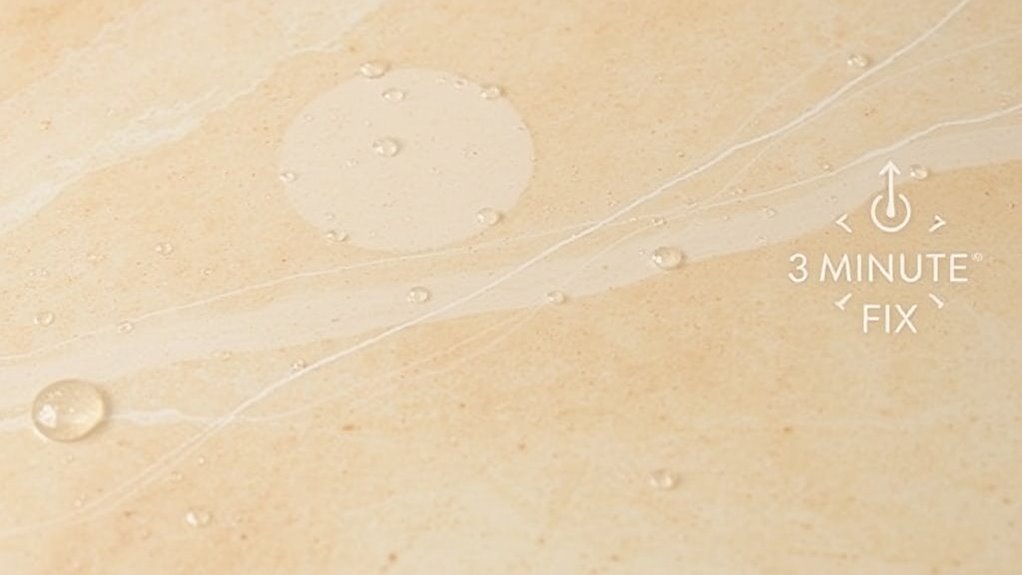
Natural stone surfaces can add elegance to any space, but squeegee streaks often mar their appearance. These streaks occur when water or cleaning solutions are improperly handled during cleaning, leaving behind unsightly marks that diminish the stone’s natural beauty. Fortunately, you can fix this problem in just a few minutes with the right cleaning techniques and surface protection strategies.
First, it’s essential to understand that cleaning techniques play a vital role in preventing and removing streaks. Always use a soft, lint-free cloth or a microfiber towel when wiping down natural stone surfaces. Avoid abrasive scrubbers or harsh chemicals, as they can damage the stone’s surface and make streaks more noticeable. Instead, dampen your cloth with warm water mixed with a pH-neutral cleaner specifically designed for natural stone. Wipe gently in a consistent, circular motion to lift dirt and residue without leaving streaks behind. After cleaning, rinse the surface with clean water to remove any leftover cleaner, then dry thoroughly with a soft towel. This process guarantees no water spots or streaks develop from leftover moisture.
Use a soft cloth and pH-neutral cleaner to wipe natural stone surfaces gently, then rinse and dry thoroughly.
Surface protection is equally important to minimize streaks and keep your stone looking pristine over time. Applying a high-quality stone sealant creates a protective barrier that repels water, dirt, and other contaminants. When you seal your stone, you reduce the likelihood of water pooling or streaks forming during routine cleaning. Make sure to reapply the sealant as recommended by the manufacturer—usually every 1-3 years—to maintain maximum protection. Additionally, consider using coasters, placemats, or mats in areas prone to spills or water exposure. These simple steps prevent excess moisture from settling on the surface, which can lead to streaks and staining. Using a quality sealant can significantly extend the lifespan and appearance of your natural stone surfaces.
Another tip is to avoid cleaning with vinegar, lemon juice, or other acidic substances, as they can etch the stone and cause uneven surfaces that are more prone to streaks. Instead, stick with pH-neutral cleaners and always dry the surface immediately after cleaning. Regular maintenance, combined with proper surface protection, keeps your natural stone surfaces looking their best and reduces the need for extensive cleaning or repairs down the line.
In just a few minutes, you can restore the natural luster of your stone and eliminate streaks by implementing effective cleaning techniques and maintaining surface protection. Consistency in your approach will guarantee your stone surfaces remain elegant and streak-free for years to come.
Frequently Asked Questions
Can Squeegee Streaks Damage Natural Stone Surfaces?
Yes, squeegee streaks can cause surface erosion and streak damage on natural stone. When you drag a squeegee across the surface, it may scratch or wear down the stone’s finish over time, especially if the streaks are persistent or abrasive. To protect your natural stone, avoid using harsh squeegees or aggressive pressure. Regularly clean and seal the surface to prevent damage and maintain its natural beauty.
Are There Specific Cleaning Tools Recommended for Natural Stone?
You should use gentle cleaning tools like soft microfiber cloths or non-abrasive sponges to protect your natural stone from damage. Avoid harsh scrub brushes or steel wool, which can scratch or etch the surface. Incorporate these tools into your maintenance routines to keep your stone pristine. Think of it as a delicate dance—using the right cleaning tools guarantees your natural stone stays flawless and stunning for years to come.
How Often Should I Clean Natural Stone to Prevent Streaks?
You should clean your natural stone at least once a week to prevent streaks and maintain its appearance. Regular cleaning helps with streak prevention by removing dirt and residue that can cause uneven reflections. Use a gentle, pH-neutral cleaner and a soft cloth or squeegee to avoid scratching or streaking. Consistent cleaning frequency guarantees your natural stone stays beautiful and streak-free over time.
Does the Type of Natural Stone Affect Streak Removal Methods?
Yes, the type of natural stone affects streak removal methods. For example, marble and limestone are more sensitive and require gentle cleaning, while granite is more durable. Always consider your stone’s porosity and sealing status when choosing cleaning products, as improper cleaning can cause streaks. Regular cleaning frequency and proper stone sealing help prevent streaks, making it easier to maintain a streak-free surface and prolong the stone’s beauty.
Can Homemade Solutions Effectively Eliminate Squeegee Streaks?
Yes, DIY remedies with household ingredients can effectively eliminate squeegee streaks on natural stone. You can mix a gentle solution using vinegar and water or baking soda and water to break down residue. Apply the solution with a soft cloth, then rinse thoroughly. These household ingredients are safe for natural stone when used correctly, making your cleaning routine both affordable and eco-friendly, and helping you restore a streak-free surface quickly.
Conclusion
Now that you’ve mastered this quick fix, you might find it’s no coincidence how often simple solutions make a big difference. With just a few minutes and the right technique, you can keep your natural stone looking flawless, no streaks in sight. Sometimes, the smallest adjustments lead to the most impressive results. So next time you notice streaks, remember—it’s as easy as a quick fix that’s conveniently right at your fingertips.
